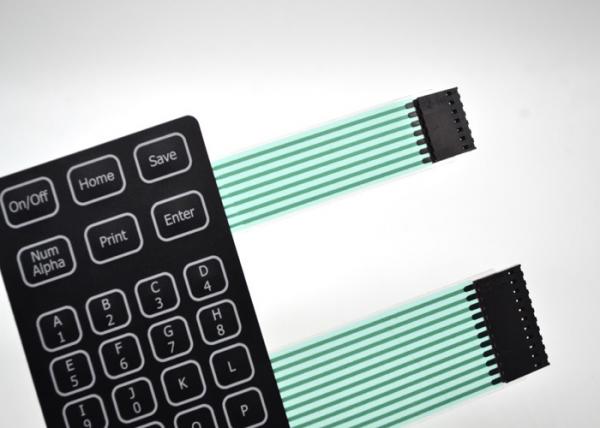Introduction of Tactile Membrane Switches
Tactile membrane switches have emerged as a popular choice across various industries due to their compact design, cost-effectiveness, and the satisfying tactile feedback they provide. These switches are incredibly versatile and adaptable, making them suitable for a multitude of applications from consumer electronics to industrial automation. This article explores the diverse uses of tactile membrane switches and highlights their importance in different sectors.

Enhanced User Experience in Consumer Electronics by Tactile Membrane Switches
In the realm of consumer electronics, tactile membrane switches are widely used in devices such as remote controls, keyboards, and gaming consoles. Their key advantage lies in the tactile feedback they offer, which enhances user interaction by providing a sense of precision and control. In mobile devices, these switches are preferred for touchpads and volume controls due to their compact size and low power consumption, contributing to the sleek and efficient design of modern gadgets.
Precision and Reliability in Medical Devices with Tactile Membrane Switches
Tactile membrane switches are critical components in the medical industry. They are integral to the functioning of surgical instruments, patient monitoring devices, and diagnostic equipment. The precise actuation and tactile response of these switches are vital for medical applications, where accuracy and reliability are paramount. Additionally, their resistance to harsh environments and their biocompatibility make them ideal for use in healthcare settings, ensuring safety and durability.
Robust Performance in Automotive Applications with Tactile Membrane Switches
In the automotive sector, the membrane switches are essential for vehicle control panels and dashboards. These switches are designed to withstand the challenging conditions within a vehicle, such as vibrations, shocks, and extreme temperatures. Their ability to provide clear tactile feedback enhances the driver’s interaction with the vehicle’s controls, contributing to improved safety and comfort. This robustness makes them well-suited for the demanding environment of automotive applications.
Durability in Industrial Automation
Industrial automation and control systems also benefit from the use of the membrane switches. These switches are known for their durability and reliability, which are crucial in environments where frequent switching and precise control are required. In applications such as assembly lines and robotics, the tactile feedback provided by these switches enhances the precision and efficiency of operator interactions, leading to smoother and more effective automation processes.
Security and Reliability in Access Control Systems
The membrane switches play a significant role in security and access control systems. Their tamper-resistant design ensures secure and reliable access to restricted areas. Moreover, their ability to provide tactile feedback is essential for confirming actions in security applications. These switches are also designed to withstand various environmental conditions and electromagnetic interference, making them a dependable choice for securing sensitive locations.
Conclusion of Tactile Membrane Switches
Tactile membrane switches are a versatile and cost-effective solution for a wide range of applications across numerous industries. Their compact size, affordability, and ability to provide tactile feedback make them indispensable in environments where precision, durability, and user interaction are critical. As technology continues to evolve, the potential applications of tactile membrane switches will expand, leading to even more innovative uses and enhanced functionality in diverse sectors.
FAQ: Applications of Tactile Membrane Switches
1.What are tactile membrane switches?
They are compact, cost-effective electronic switches that provide tactile feedback when pressed. This feedback allows users to feel a response, which enhances precision and interaction.
2.Why are tactile membrane switches popular in consumer electronics?
These switches are favored in consumer electronics such as remote controls, keyboards, and gaming devices due to their ability to enhance user experience. Their tactile feedback provides a sense of control and precision. They are also suitable for mobile devices because of their compact size and low power consumption.
3. How are tactile membrane switches used in medical devices?
In the medical industry, tactile membrane switches are crucial for surgical instruments, patient monitoring devices, and diagnostic equipment. They provide precise actuation and tactile response, essential for accurate and reliable medical applications. Their resistance to harsh environments and biocompatibility make them ideal for healthcare settings.
4. What makes tactile membrane switches suitable for automotive applications?
Tactile membrane switches are integral to vehicle control panels and dashboards. They can withstand harsh automotive conditions, such as vibrations and extreme temperatures. Their clear tactile feedback enhances driver interaction with vehicle controls, contributing to safety and comfort.
5. How do tactile membrane switches benefit industrial automation?
In industrial automation and control systems, these switches are valued for their durability and reliability. They are ideal for applications requiring frequent switching and precise control. In settings like assembly lines and robotics, their tactile feedback improves operator interaction and process efficiency.
6. In what ways do tactile membrane switches enhance security and access control systems?
They are used in security and access control systems due to their tamper-resistant design and reliable tactile feedback. They ensure secure and reliable access to sensitive areas and are built to resist environmental conditions and electromagnetic interference.
7. What are the overall advantages of using tactile membrane switches across various industries?
They offer several advantages, including compact size, low production cost, and satisfying tactile feedback. These features make them ideal for applications requiring precision, durability, and user interaction. Their versatility allows them to be used effectively across many sectors, from consumer electronics to industrial automation.
8. How might the use of tactile membrane switches evolve in the future?
As technology advances, the applications of the membrane switches are expected to grow. Innovations in their design and functionality will likely lead to new and enhanced uses across a wide range of industries, providing even greater benefits in terms of performance and user interaction.
